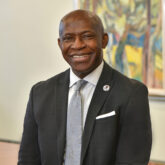Enthusias-Tech Classrooms: Alumni Educators Bring Technology’s ‘Cool Factor’ to Life
In Loudoun County, Va., a tiny village has been built using engineering software and a 3D printer.
The village’s roads and bridges have been tested for vehicle safety using coded robotics—although the transportation engineers who conducted the testing are still years away from being old enough to legally drive.
That’s b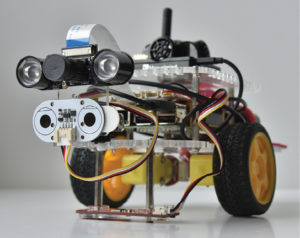 ecause the architects, engineers and manufacturers of this replica community are only in the fourth grade.
ecause the architects, engineers and manufacturers of this replica community are only in the fourth grade.
“We have changed the path of learning here,” said The Washington Post’s 2018 Principal of the Year Paul Pack ’01, principal of the STEM immersion school, Liberty Elementary. “Unlike traditional learning, consumption of information is not encouraged. Instead, students work together using technology to redefine learning experiences.”
In today’s classroom, technology is about being relevant, cutting edge, job-ready and progressively competitive.
And, it’s also just plain cool.
From 3D printers to goggles that allow students to amble through the outback of Australia as a sensory experience, technology-heavy classrooms have no shortage of students willing to immerse themselves in the fast-paced world of applied science. And, educators have to work hard to keep up.
SUNY Oswego’s technology-driven educators are doing exactly that. Paul started his career in the district more than 15 years ago; he was at the helm of Liberty’s transition to a more STEM-friendly school. Paul converted Liberty’s traditional computer lab into a SMART Lab that encourages students to work collaboratively with new technology.
“Seeing it play out in the classroom elevated even my expectations,” Paul said. “Now, these types of projects are commonplace at Liberty. It was so eye-opening.”
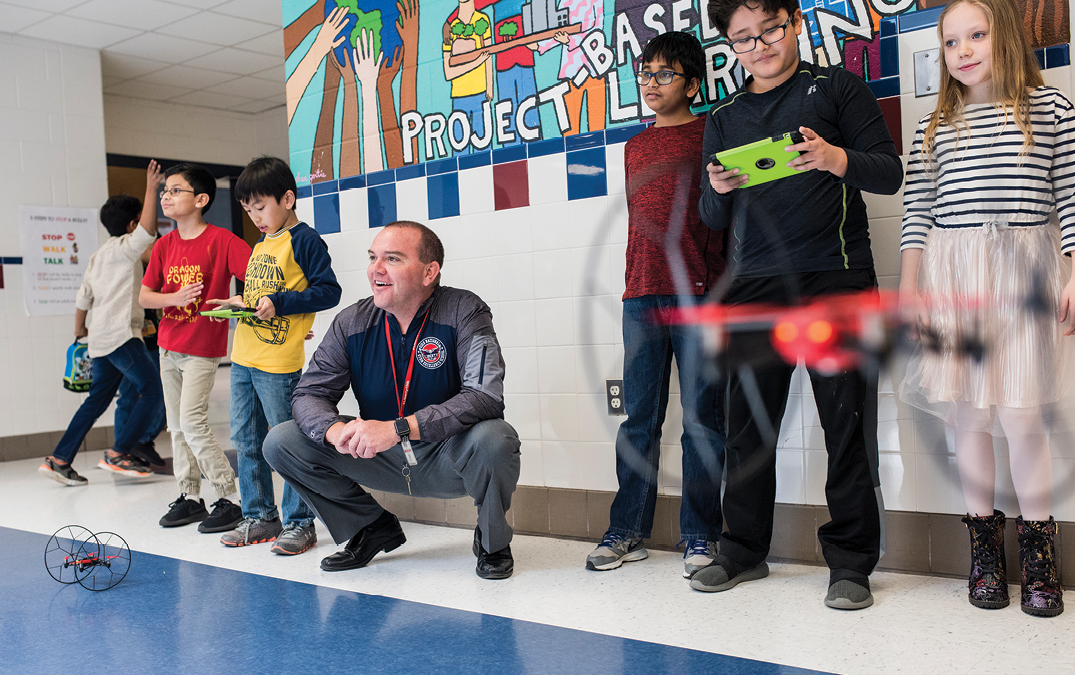
Paul Pack ’01
Part of an E-volution
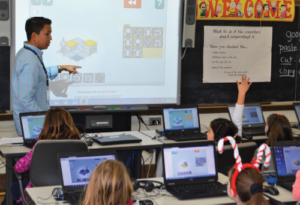
John Sebalos ’05
John Sebalos ’05, director of technology for Pelham (N.Y.) Public Schools, has been a tech leader in downstate New York school districts for more than 12 years, working both with students and in staff development. In 2009, he was part of a grant program that received national attention on CNN for doing the unthinkable: 100 fifth graders were given smartphones to use in the classroom, at a time when many schools were confiscating and banning them.
“I was able to see how easy it was for them to collaborate,” said John, who said that today’s young students are not necessarily tech savvy—but they are usually “tech comfy”—fearless when it comes to using the newest gadgets and software. Where educators can be most effective, he said, is teaching them to use technology in a productive and meaningful way.
“We can be instrumental in harnessing their skills to be contributors to society, not just consumers of content,” John said. It is, in fact, the trend; young people are becoming collaborative content creators through technological advances, and they can both connect and troubleshoot on a global level, he said.
For John, who credits his high level of involvement in Greek life at SUNY Oswego (Sigma Alpha Epsilon) for developing his soft skills and calls his student-teaching in Red Creek, N.Y., a highlight of his time at Oswego, applying a passion for technology yields results: college-ready and work-ready students.
“I grew up analog but we were exposed to digital, and everyone just knew it was going to be huge—and huge in schools,” he said. “Digital technology allowed me the opportunity to apply what I love in the classroom.”
 Mark Quintana ’94 was an intern on the floor of the New York State Stock Exchange when he realized his true calling: education and technology.
Mark Quintana ’94 was an intern on the floor of the New York State Stock Exchange when he realized his true calling: education and technology.
The Long Island native who graduated with an economics degree from Oswego decided to change direction and head to Florida, where he was an educator and ultimately earned a doctoral degree in child and youth studies. His career trajectory placed him in one of the largest public school districts in the nation—Broward County—where he worked for years to integrate technology in the classroom.
“Even as a budding administrator I tended toward the techie side,” Mark said. In 2014, he landed in a position that saw him serving the hardware and software needs of school districts on a national level as a senior education consultant for Promethean.
The classroom spaces that Mark helps districts design and build include equipment that is unrecognizable to those educated in the not-so-distant chalk-dusty eraser past: interactive and high-definition panels, whiteboards and trips to museums around the world via virtual reality, to name just a few updates in recent years.
“School districts know they need to offer state-of-the-art equipment for college and career readiness,” he said. The pressure to be continually progressive is made more difficult by the speed with which technology is outdated, and the cost to keep it current.
It has forced districts to be creative to keep pace.
“The world will move forward, and we can’t fall behind,” he said. “It’s really a national issue for us.”
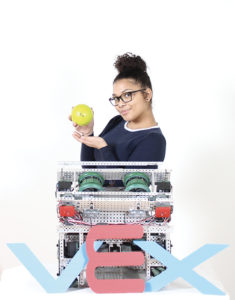
Alexis Williams ’18
And those who are just entering the field are expected to hit the ground running. Districts compete hard for the newest talent. Alexis Williams ’18 was hired to be the technology teacher for the sizeable Manhasset School District in Nassau County, N.Y., before she’d even graduated in May 2018.
Alexis is teaching Robotics & Engineering as well as Design & Modeling for the district; she received five school district job offers before graduation and still receives phone calls for interviews from across the state.
“When they [school districts] hear you have a degree from SUNY Oswego, the opportunities become limitless because of its long, rich history in technology education,” said Alexis, who was active in VEX robotic training (see inset) during her time on campus. ”I plan to light a fire of curiosity within my students and watch it spread like wildfire, just as my professors at SUNY Oswego have done for me.” —Eileen Moran
“I plan to light a fire
of curiosity within my students and watch it spread like wildfire, just as my
professors at SUNY Oswego have done for me.”
–Alexis Williams ’18
Jumping Off the Page into the Minds of Children
When students at Oswego’s Fitzhugh Elementary School became frustrated with the instruction booklets provided with robot-making kits, two alumnae made those instructions jump right off the page—a project that ultimately earned them international recognition.
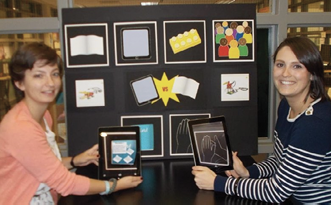
Carly Karas ’12 M’14 (left) and Patricia Tanner Terrance M’14 (right) were in the human-computer interaction master’s program, working with young students on the topic of robotics using Lego Mindstorm Robots. Students learned the functions of a robot and were given the experience of building one on their own.
And that’s when the trouble started.
The 2D-drawings in the instruction manuals—think IKEA instructions—weren’t informative enough for the students to use.
“Manuals and diagrams can be really hard to translate into the real world for children,” Carly said. “The manuals didn’t include any text or much support besides single, static diagrams of how the robot should look at each step, and it requires a lot of spatial reasoning. We knew that in order to give these kids the best information on how these pieces are supposed to fit together, we had to give them dynamic tools.”
So the alumnae used HP Reveal software to build augmented reality (AR) versions of the instructions. The result: the robots appeared to rise from the instruction page itself into a 3D-representation of the mechanics of putting them together, complete with voiceover instructions provided by the alumnae. Through augmented reality and an iPad, students were able to view the robot being pieced together from all angles and listen to guidance. The build success rate was much higher. In fact, the team’s work is still used by young students in the school today.
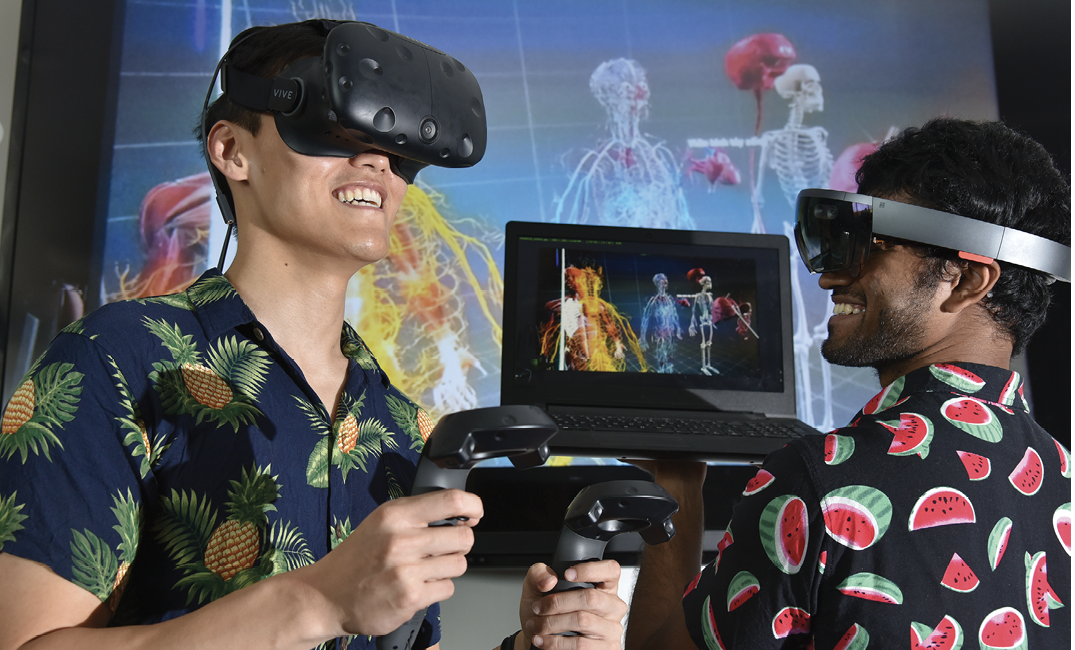
Human-computer interaction master’s degree candidates Zhushun “Tim” Cai M’18 (left) and Oliver Medonza ‘16 M’18 (right) are immersed in virtual and augmented digital environments in the college’s first dedicated Virtual Reality (VR) lab in the Shineman Center, which includes state-of-the-art VR headsets and other VR technology.
“It is interesting to see how far AR has grown since working on this project,” Patricia said. “Technology and gaming have always had a tight bond. I am particularly proud, however, that Carly and I were able to make a case that this technology has a place in education, as well.”
Carly traveled to Australia with Professor Damian Schofield to present their project at an international conference, and their work was subsequently published in the Journal of Information Technology Education: Innovations in Practice. Patricia didn’t attend the Australian conference for a good reason: She was working on a similar project in Brazil at the time.
Today, Patricia is a digital research consultant at Wells Fargo in Charlotte, N.C., and Carly is a user experience strategist and researcher for design studio P’unk Ave in Philadelphia, Pa. l —Eileen Moran
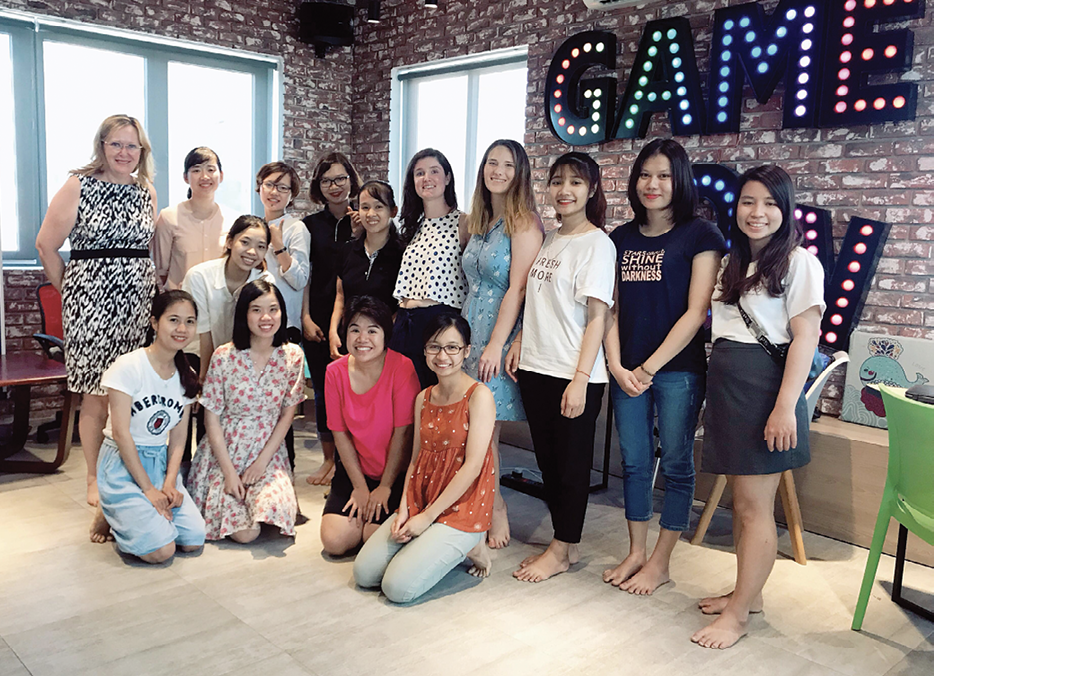
SUNY Oswego students participated in a Girls Who Code Vietnam workshop at Enouvo Space with a group of women interested in teaching girls how to do computer programming.
International Partnerships, Women Empowering Women In HCI Program
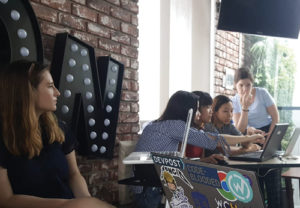
SUNY Oswego student Tara O’Grady ’16 M’19 (standing) helped other women programmers work through issues with their Python code while Annie Reynolds ’18 M’19 (left) manned the laptop for a presentation.
When a research group at Duy Tan University needed help designing new interfaces for medical virtual reality software, SUNY Oswego alumni and master’s degree students hopped a plane to Vietnam.
Among the seven students were Annie Reynolds ’18 M’19 and Tara O’Grady ’16 M’19, who spent over two months in Vietnam in summer 2018, working on the mobile and desktop interfaces for virtual reality, mixed reality and augmented reality software geared toward students trying to learn anatomy and physiology.
“We would wake up at our apartment and ride our motorbikes across the Dragon Bridge to the university,” Annie said. “We worked exclusively in Axure [software] for prototyping, creating the designs and interactions. We would use a whiteboard to discuss problems with functionality and design, and create new solutions.”
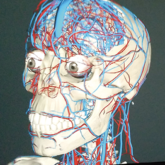
A visual of the interface for medical virtual reality software, which SUNY Oswego students helped develop.
The international experience was coordinated by Dr. Damian Schofield, who teaches in the computer science department and is the director of SUNY Oswego’s human-computer interaction programs, in partnership with former SUNY Oswego Professor Jolanda Tromp, who is now based at the Vietnam university. According to Damian, it’s just one of many opportunities for students to take their education to a global, hands-on level. And for Annie and Tara, it was an opportunity to take another passion abroad.
Annie and Tara are the Oswego founders of a program called Girls Who Code, an extension of a national initiative with a single goal: to close the gender gap in technology. Beginning in 2017, the pair has welcomed as many as 25 local high school girls to the SUNY Oswego campus on Sunday afternoons for lessons and fellowship surrounding coding, which is the foundation of computer programming to create computer software, apps and websites.
So when they traveled to Vietnam, Annie and Tara decided to run workshops so that a Girls Who Code group can be formed there, too.
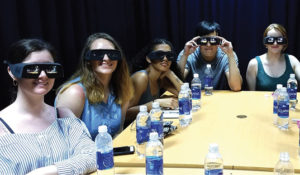
SUNY Oswego students (from left) Tara O’Grady ’16 M’19, Annie Reynolds ’18 M’19, Kristen Ray ’18, Zhushun “Tim” Cai M’18 and Noelle LeRoy ’17 donned their virtual reality glasses to see a new version of the world around them.
“We worked with women on how to approach the fear of failure and instill confidence in young girls, exposed them to famous women in STEM fields to provide representation and gave them the tools to create their own clubs to teach young girls in Vietnam how to program,” Annie said.
Girls Who Code is a program that yields results that benefit all of the science fields, Damian said.
“The evidence is overwhelming,” Damian said. “The percentage of women who go into the science fields following their involvement in a club like Girls Who Code is 10 times the national average.”
And according to Annie, who previously served as the president of the SUNY Oswego Women in Computing Club, the impact can also be much more personal.
In Vietnam, the students met a woman through their Girls Who Code workshops who touched them deeply. The woman used a wooden prosthetic leg to walk; it was among other injuries that had happened as a result of exposure to Agent Orange.
“She grew up in a very poor family and had to overcome a lot of obstacles in her life,” Annie said. “She had learned how to program and other basic life skills. She was so excited to learn from our experiences. It was an honor to meet her. I cannot wait to have more women like her serve as representatives in tech fields for younger generations.”
And the younger generations are stepping up to the challenge, Tara said. One of the teen girls in the Oswego club took on a very ambitious project: A GoPiGo robot car. Word of the project spread in the computer science department, and college students and faculty popped in on a Sunday club meeting to help her accomplish her goal.
“It really was impressive. She was programming the same robots that software engineer majors were working with,” Tara said.

Taking in the wonders of the country—including a rafting trip in the Red River Delta—were part of the experience for SUNY Oswego students.
Tara, who was asked by Annie to help create the Girls Who Code club after Annie attended a conference, said the gender gap is glaringly obvious; most programming classes on campus have very few women.
“I only realized my love for tech when I came to college and often wish I had the exposure when I was younger,” Tara said. “So being able to do this for young girls in the community is amazing.”
Technology is universal, so to exclude women from the conversation is to lose half of the world’s experiences, Annie said.
“It’s a slow process to get women into tech fields because you’re undoing years of doubts and stereotypes,” she said. “Through STEM programs that reach a wide audience of all types of young girls, I am more confident that we can have more women in tech fields.”
Sharing that confidence on an international level—including Vietnam—has its perks.
“We were living by the beautiful beaches with mountains in the background, riding through small towns nestled in thick green jungles, sitting on our rooftop deck, drinking world-renowned coffee, and enjoying the kindness and warmth of the people,” Annie said. l
—Eileen Moran
Mark Quintana is senior director of strategic partnerships for AdvancED, which provides continuous improvement services to schools and school districts domestically and internationally.
5 Ways to Integrate Technology into the Classroom (provided by Mark Quintana):
1. As supported by the University of South Florida’s Technology Integration Matrix (TIM) and AdvancED’s Effective Learning Environment Observation Tool (eleot), use technology programs that flip the classroom around where the students are the center of the classroom and develop their own learning with their choice of technology programs and content. The teacher’s role evolves into one of a facilitator, where they are not the content expert nor the ‘sage on the stage’. The planning process becomes ever more important as teachers guide students to create their own knowledge, and provide options of choice for content while also remaining in alignment with academic standards.
2. Embrace students collaborating with and around technology. There does not need to be 1:1 student to technology devices for technology to be used in the classroom. A small group of students can collaborate around a device. In this manner instruction with technology is also supporting social skill development and cooperative learning experiences.
3. Have technology centers in the classroom. This is most common at the elementary level but does not have to be. There is no reason that rotations around technology can not occur at the middle and high school levels, especially when there is not a 1:1 ratio of student to device.
4. Accept that student cell phones can support teaching and learning. This is a manner that can help bridge the divide for those without regular access to tablets, laptops or computers. School and district policies that do not support bring your own device (BYOD) initiatives are missing a great opportunity to bring teaching and learning processes directly to meet students where they are very naturally engaged and spend a lot of time voluntarily.
5. Model the use of technology for students and parents. Show the students that you, too, are using technology in your work for the times where you are providing instruction. There are programs where content can be sent to student devices and/or formative assessment questions can be asked of students with devices (even if the devices are shared). Do the same thing when presenting information to parents. It will give them a taste of what their children are experiencing during the school day. In both cases, an important result will be increased engagement. As it relates to students, this is an important component to increasing student achievement.
More from Fall 2018
Tech & Marketing
Waves of Success A passion for weather and water led New York City native Jeff Ragovin ’00 to the shores of Lake Ontario. …
Rankings Round-Up
Top Regional Universities in the North SUNY Oswego has once again earned a top 50 ranking in the 2019 “Top Regional …
Welcoming Torchlight Ceremony Celebrates New Students, Most Diverse Class in History
College President Deborah F. Stanley, student speaker Boni Quatroche ’19, Student Association President Omar van Reenan ’19, Victoria Kammer ’20, faculty and staff …










